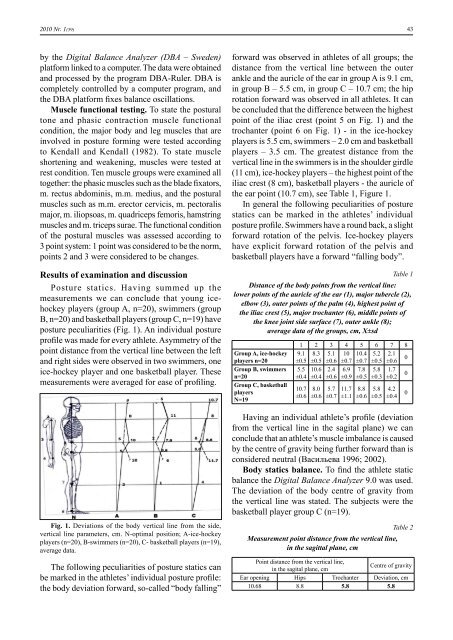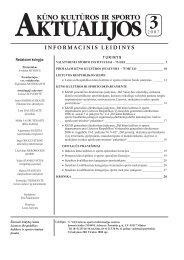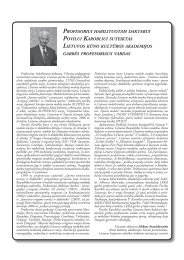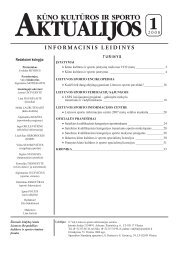Nr. 1 - Lietuvos sporto informacijos centras
Nr. 1 - Lietuvos sporto informacijos centras
Nr. 1 - Lietuvos sporto informacijos centras
You also want an ePaper? Increase the reach of your titles
YUMPU automatically turns print PDFs into web optimized ePapers that Google loves.
2010 <strong>Nr</strong>. 1(59)<br />
43<br />
by the Digital Balance Analyzer (DBA – Sweden)<br />
platform linked to a computer. The data were obtained<br />
and processed by the program DBA-Ruler. DBA is<br />
completely controlled by a computer program, and<br />
the DBA platform fixes balance oscillations.<br />
Muscle functional testing. To state the postural<br />
tone and phasic contraction muscle functional<br />
condition, the major body and leg muscles that are<br />
involved in posture forming were tested according<br />
to Kendall and Kendall (1982). To state muscle<br />
shortening and weakening, muscles were tested at<br />
rest condition. Ten muscle groups were examined all<br />
together: the phasic muscles such as the blade fixators,<br />
m. rectus abdominis, m.m. medius, and the postural<br />
muscles such as m.m. erector cervicis, m. pectoralis<br />
major, m. iliopsoas, m. quadriceps femoris, hamstring<br />
muscles and m. triceps surae. The functional condition<br />
of the postural muscles was assessed according to<br />
3 point system: 1 point was considered to be the norm,<br />
points 2 and 3 were considered to be changes.<br />
Results of examination and discussion<br />
Posture statics. Having summed up the<br />
measurements we can conclude that young icehockey<br />
players (group A, n=20), swimmers (group<br />
B, n=20) and basketball players (group C, n=19) have<br />
posture peculiarities (Fig. 1). An individual posture<br />
profile was made for every athlete. Asymmetry of the<br />
point distance from the vertical line between the left<br />
and right sides were observed in two swimmers, one<br />
ice-hockey player and one basketball player. These<br />
measurements were averaged for ease of profiling.<br />
forward was observed in athletes of all groups; the<br />
distance from the vertical line between the outer<br />
ankle and the auricle of the ear in group A is 9.1 cm,<br />
in group B – 5.5 cm, in group C – 10.7 cm; the hip<br />
rotation forward was observed in all athletes. It can<br />
be concluded that the difference between the highest<br />
point of the iliac crest (point 5 on Fig. 1) and the<br />
trochanter (point 6 on Fig. 1) - in the ice-hockey<br />
players is 5.5 cm, swimmers – 2.0 cm and basketball<br />
players – 3.5 cm. The greatest distance from the<br />
vertical line in the swimmers is in the shoulder girdle<br />
(11 cm), ice-hockey players – the highest point of the<br />
iliac crest (8 cm), basketball players - the auricle of<br />
the ear point (10.7 cm), see Table 1, Figure 1.<br />
In general the following peculiarities of posture<br />
statics can be marked in the athletes’ individual<br />
posture profile. Swimmers have a round back, a slight<br />
forward rotation of the pelvis. Ice-hockey players<br />
have explicit forward rotation of the pelvis and<br />
basketball players have a forward “falling body”.<br />
Table 1<br />
Distance of the body points from the vertical line:<br />
lower points of the auricle of the ear (1), major tubercle (2),<br />
elbow (3), outer points of the palm (4), highest point of<br />
the iliac crest (5), major trochanter (6), middle points of<br />
the knee joint side surface (7), outer ankle (8);<br />
average data of the groups, cm, X±sd<br />
Group A, ice-hockey<br />
players n=20<br />
Group B, swimmers<br />
n=20<br />
Group C, basketball<br />
players<br />
N=19<br />
1 2 3 4 5 6 7 8<br />
9.1<br />
±0.5<br />
5.5<br />
±0.4<br />
10.7<br />
±0.6<br />
8.3<br />
±0.5<br />
10.6<br />
±0.4<br />
8.0<br />
±0.6<br />
5.1<br />
±0.6<br />
2.4<br />
±0.6<br />
5.7<br />
±0.7<br />
10<br />
±0.7<br />
6.9<br />
±0.9<br />
11.7<br />
±1.1<br />
10.4<br />
±0.7<br />
7.8<br />
±0.5<br />
8.8<br />
±0.6<br />
5.2<br />
±0.5<br />
5.8<br />
±0.3<br />
5.8<br />
±0.5<br />
2.1<br />
±0.6<br />
1.7<br />
±0.2<br />
4.2<br />
±0.4<br />
0<br />
0<br />
0<br />
Having an individual athlete’s profile (deviation<br />
from the vertical line in the sagital plane) we can<br />
conclude that an athlete’s muscle imbalance is caused<br />
by the centre of gravity being further forward than is<br />
considered neutral (Васильева 1996; 2002).<br />
Body statics balance. To find the athlete static<br />
balance the Digital Balance Analyzer 9.0 was used.<br />
The deviation of the body centre of gravity from<br />
the vertical line was stated. The subjects were the<br />
basketball player group C (n=19).<br />
Fig. 1. Deviations of the body vertical line from the side,<br />
vertical line parameters, cm. N-optimal position; A-ice-hockey<br />
players (n=20), B-swimmers (n=20), C- basketball players (n=19),<br />
average data.<br />
The following peculiarities of posture statics can<br />
be marked in the athletes’ individual posture profile:<br />
the body deviation forward, so-called “body falling”<br />
Table 2<br />
Measurement point distance from the vertical line,<br />
in the sagittal plane, cm<br />
Point distance from the vertical line,<br />
in the sagital plane, cm<br />
Centre of gravity<br />
Ear opening Hips Trochanter Deviation, cm<br />
10.68 8.8 5.8 5.8
















